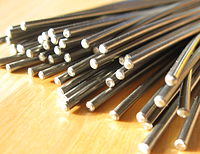
Photo from wikipedia
The aim of this in vitro study was to analyze, both experimentally and theoretically, the mechanical behavior of two types of composite materials used in restoring dental integrity. The samples… Click to show full abstract
The aim of this in vitro study was to analyze, both experimentally and theoretically, the mechanical behavior of two types of composite materials used in restoring dental integrity. The samples of each composite resin, namely Filtek Supreme XT (3M ESPE, St. Paul, MN, USA) and Filtek Z250 (3M ESPE, St. Paul, MN, USA), were experimentally analyzed by determining their compressive strength and fracture behavior. The fractured fragments of the samples were subjected to surface evaluation by scanning electron microscopy. The compressive stress—compressive strain dependencies revealed stronger cracking of the Filtek Supreme XT composite than Filtek Z250 prior to fracture. Theoretically, the evaluation was made by means of holographic implementations of such types of composite materials. A Hooke-type equation in a differential form is presented, which links the proposed theoretical model with the experimentally obtained data.
Journal Title: International Journal of Molecular Sciences
Year Published: 2023
Link to full text (if available)
Share on Social Media: Sign Up to like & get
recommendations!